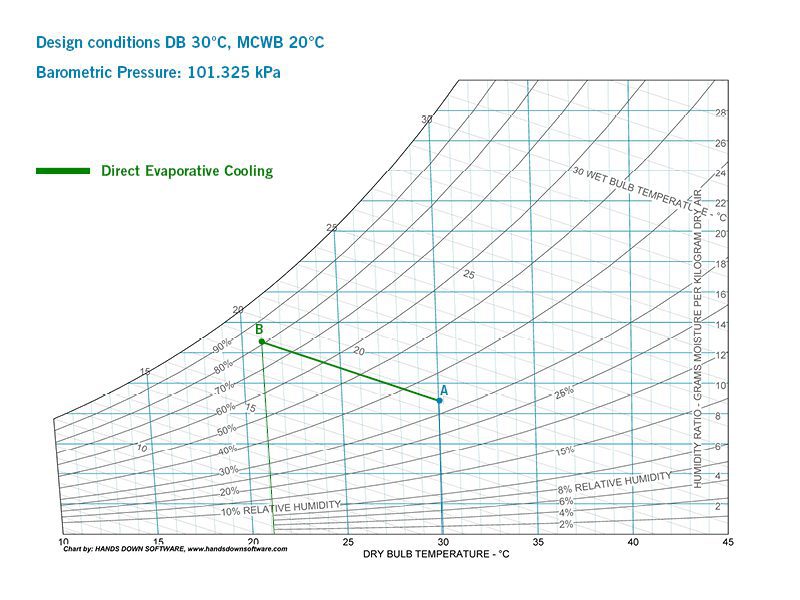Evaporative cooling is now becoming very popular. It is one of the most efficient cooling technologies available in the United Kingdom. What are the properties behind this technology? Let’s discover them through this article.
Direct evaporative cooling is the simplest form of evaporative cooling. The system uses a fan to draw air from the outside environment. This air then passes through wet “cooling pads”. The water absorbs the heat from the air as it evaporates from the cooling pads. The motor pushes this air (that has a lower temperature) into the building.
To understand how evaporative cooling works, it is essential to have a clear idea of Psychrometrics. This consist of an interaction between moisture, heat and air. As temperature rises, its capacity to hold moisture rises as well. Moisture is therefore a very influential factor for heat gain. The Psychrometric Chart explains the interaction between the three elements stated above.

The Elements of a Psychrometric chart:
DRY BULB TEMPERATURE (DBT):
Refers to the ambient air temperature that we can measure using a normal thermometer. It is “dry” because the moisture of the air does not affect it. The dry bulb temperature is an indicator of heat content of the air if all other factors remain constant. As the DBT temperature increases, the capacity of moisture the airspace will hold also increases.
WET BULB TEMPERATURE (WBT):
The Wet Bulb temperature is the temperature that we can measure by using a thermometer whose glass bulb is covered by a wet cloth. The wet bulb temperature indicates the moisture content of air. It is extremely important to consider the WBT for evaporating cooling processes because the difference between the dry bulb and wet bulb temperature is a measure of the cooling efficiency. At 100% relative humidity, the wet bulb temperature equals dry bulb temperature.
HUMIDITY:
Describes the quantity of water vapour in the air. We can consider two types of humidity:
- Absolute humidity: the mass of water vapour present in a given mass of air. It is expressed in grams of water vapour (g) per kilogram of dry air (kg).
- Relative humidity (RH): the actual amount of moisture in the air compared to the total or maximum moisture the air can hold at a given temperature. When air has 50 percent RH, we say it is 50 percent saturated. As air approaches 100 percent saturation, it can take on less and less water until at 100 percent RH, the air cannot hold more water.
How to read a Psychrometric chart:
In Evaporative cooling, we move in the chart along lines of constant enthalpy: this means we are talking about an adiabatic process, where no transfer of heat occurs.
Moving in the psychrometric chart from point A along a line of constant enthalpy we are adding moisture to the air (vertical axis), and proportionally obtaining a drop in Dry Bulb Temperature (horizontal axis). With evaporative cooling, the possible maximum reduction in temperature is the differential between the Dry Bulb and the Wet Bulb temperature (called Wet Bulb Depression): this means we could move along the line until point C, where Relative Humidity is 100%. However, no equipment is perfect, so there will be certain losses in the cooler: if we consider a cooler 90% efficient, we can then reach point B, therefore obtaining a temperature drop of 11.5°C.
If you are curious to see in which sectors you can effectively install evaporative cooling, read this article.
If you have any queries, contact our office in the United Kingdom.
Visit our Learning Centre for more articles.
